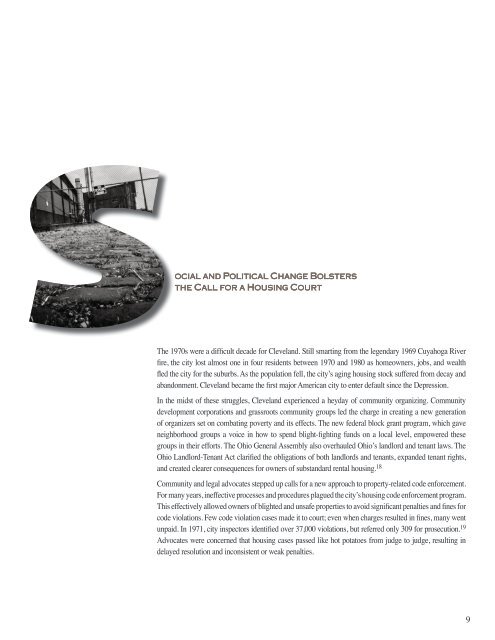publication for website
You also want an ePaper? Increase the reach of your titles
YUMPU automatically turns print PDFs into web optimized ePapers that Google loves.
ocial and Political Change Bolsters<br />
the Call <strong>for</strong> a Housing Court<br />
The 1970s were a difficult decade <strong>for</strong> Cleveland. Still smarting from the legendary 1969 Cuyahoga River<br />
fire, the city lost almost one in four residents between 1970 and 1980 as homeowners, jobs, and wealth<br />
fled the city <strong>for</strong> the suburbs. As the population fell, the city’s aging housing stock suffered from decay and<br />
abandonment. Cleveland became the first major American city to enter default since the Depression.<br />
In the midst of these struggles, Cleveland experienced a heyday of community organizing. Community<br />
development corporations and grassroots community groups led the charge in creating a new generation<br />
of organizers set on combating poverty and its effects. The new federal block grant program, which gave<br />
neighborhood groups a voice in how to spend blight-fighting funds on a local level, empowered these<br />
groups in their ef<strong>for</strong>ts. The Ohio General Assembly also overhauled Ohio’s landlord and tenant laws. The<br />
Ohio Landlord-Tenant Act clarified the obligations of both landlords and tenants, expanded tenant rights,<br />
and created clearer consequences <strong>for</strong> owners of substandard rental housing. 18<br />
Community and legal advocates stepped up calls <strong>for</strong> a new approach to property-related code en<strong>for</strong>cement.<br />
For many years, ineffective processes and procedures plagued the city’s housing code en<strong>for</strong>cement program.<br />
This effectively allowed owners of blighted and unsafe properties to avoid significant penalties and fines <strong>for</strong><br />
code violations. Few code violation cases made it to court; even when charges resulted in fines, many went<br />
unpaid. In 1971, city inspectors identified over 37,000 violations, but referred only 309 <strong>for</strong> prosecution. 19<br />
Advocates were concerned that housing cases passed like hot potatoes from judge to judge, resulting in<br />
delayed resolution and inconsistent or weak penalties.<br />
9



